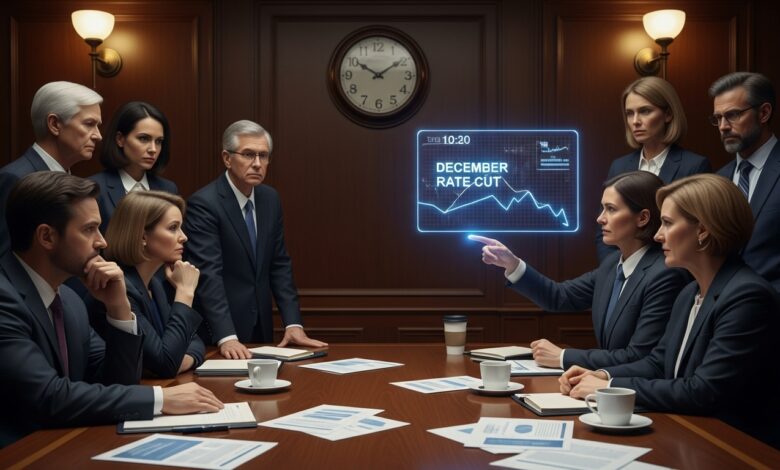
Fed Officials Split as Markets Price. After more than two years of aggressive monetary tightening and a cautious pivot toward easing, the Federal Reserve has entered one of its most delicate phases yet. Markets are again betting on a December rate cut, but this time the path is anything but clear.Futures markets currently imply roughly two-thirds odds of a 25-basis-point cut at the Federal Open Market Committee (FOMC) meeting scheduled for December 9–10, 2025. That’s down from levels above 90% right after the Fed’s October move, as traders have scaled back their conviction that another interest rate cut is a done deal.
At the same time, Fed officials are openly split. Some policymakers argue that persistent inflation and still-firm pricing power in many businesses mean the central bank should pause in December. Others worry that a softening labor market and rising unemployment justify another December rate cut to prevent a deeper slowdown. Recent public remarks from officials like San Francisco Fed President Mary Daly and regional bank presidents Raphael Bostic and Susan Collins underscore just how divided the institution has become.
To make matters more complicated, a prolonged U.S. government shutdown has delayed key releases of inflation and jobs data, leaving the Fed “driving through the fog,” as Chair Jerome Powell has put it previously. The result is a central bank wrestling with incomplete information, while markets, stocks, bonds, and the U.S. dollar all react to each new headline about the December rate cut debate. Fed Officials Split as Markets Price.
In this article, we’ll break down why Fed officials are divided, what markets are pricing in, how previous cuts have shaped the current environment, and what a potential December rate cut could mean for your portfolio, your mortgage, and the broader economy. Fed Officials Split as Markets Price.
How We Got to the December Rate Cut Debate Fed Officials Split as Markets

From aggressive hikes to cautious easing
Starting in early 2022, the Federal Reserve launched one of the fastest interest rate hiking cycles in decades to tackle inflation that peaked near 9%. The federal funds rate climbed from near zero to well above 5%, putting intense pressure on borrowing costs across the economy.
By late 2024, inflation had moderated, but it remained above the Fed’s 2% target. In December 2024, the central bank delivered the third in a string of rate cuts, closing the year with the policy range at around 4.25%–4.5%. Those moves were designed to prevent tight monetary policy from tipping the economy into a recession while still keeping inflation expectations anchored.
Heading into 2025, officials signaled that any additional easing would be gradual and data-dependent. Minutes released from the December 2024 meeting highlighted that the decision to cut was a “close call,” revealing a Fed already uneasy about how quickly to move toward easier policy. Fed Officials Split as Markets Price.
The first cuts of 2025 and their impact
After holding rates steady for several months, the Fed finally delivered its first rate cut of 2025 in September, trimming the benchmark rate by 25 basis points to a range. Officials cited a cooling labor market, slower payroll growth, and weaker factory activity as key reasons for the shift.
That September move, followed by an additional cut in late October, signaled the start of a new easing cycle. Initially, markets cheered. Equities rallied, bond yields eased, and traders quickly priced in another December rate cut, assuming the Fed would follow a familiar pattern of gradual but steady easing.
However, the optimism didn’t last. That’s when the gap between what markets priced in and what Fed officials were saying began to widen. Fed Officials Split as Markets Price.
Why Fed Officials Are Split Fed Officials Split as Markets
Inflation is still above target
One side of the debate is driven by lingering concern about sticky inflation. While headline inflation has cooled from its 2022 highs, it remains above the Fed’s 2% goal, and services inflation in particular has shown renewed firmness in recent months.
Officials like Boston Fed President Susan Collins and Atlanta Fed President Raphael Bostic have warned that cutting rates too quickly could allow inflation pressures to become entrenched again. They point to surveys showing that many businesses still plan price increases in the coming year, as well as wage growth that, while moderating, remains elevated by historical standards.
For these policymakers, the risk of moving too fast on December rate cuts is clear: if inflation flares up again, the Fed might have to reverse course and hike, damaging its credibility and forcing even more painful tightening down the road. Fed Officials Split as Markets Price.
Labor market shows growing signs of stress
On the other side of the argument are officials who worry more about the labor market and broader economic momentum. Unemployment has drifted higher, job openings have declined, and hiring has slowed, signaling that the once red-hot jobs market is cooling.
San Francisco Fed President Mary Daly, for instance, has emphasized that the risks to the Fed’s dual mandate—price stability and maximum employment—are now more “balanced,” with a slight tilt toward employment concerns. She has said she remains open-minded about a December rate cut, noting that inflation has not risen as much as many expected while employment has weakened more than anticipated.
For this camp, another December rate cut could help cushion the slowdown and prevent a sharper rise in unemployment, especially if incoming data confirms that disinflation remains intact.
Data gaps and policy uncertainty
Complicating the split is the fact that policymakers are working with incomplete information. A government shutdown has delayed or disrupted the release of key reports, including some jobs and inflation data for the autumn months.
Without a full data picture, officials are forced to lean more heavily on partial indicators and real-time market signals. Some argue this calls for caution and a pause in December; others say that with the direction of travel already toward easing, the Fed should err on the side of supporting growth.
The result is a rare public policy split within the Fed, one that has few precedents during Jerome Powell’s nearly eight-year tenure as chair. Fed Officials Split as Markets Price.
What Markets Are Pricing In for December

Futures, FedWatch tools and implied probabilities
Despite the internal split, markets still assign a meaningful probability to a December rate cut. Tools such as the CME FedWatch and similar Fed rate monitor dashboards use Fed funds futures prices to translate market bets into odds for upcoming FOMC decisions.
As of early November, those futures implied roughly a 64%–70% chance of a 25-basis-point cut at the December meeting. That’s a noticeable step down from the more than 90% odds seen immediately after the October cut, but it still indicates that traders view further easing as more likely than not.
This divergence between market expectations and Fed rhetoric is crucial. If investors are leaning heavily toward a December rate cut, but policymakers ultimately decide to hold rates steady, the surprise could jolt bond yields, stock valuations, and currency markets. Fed Officials Split as Markets Price.
How stocks, bonds and the dollar are reacting
The shifting odds of a December rate cut have already left their mark on asset prices. As the probability of another cut has fallen from its peak, major stock indices have come under pressure, particularly momentum names that had benefited from hopes of faster easing.
US Treasury yields have seesawed as traders try to reconcile mixed signals: stubborn core inflation on one hand, and weaker job growth on the other. When comments from hawkish officials hit the wires, yields tend to rise as markets price out cuts. When more dovish voices or softer data emerge, yields fall and the dollar often weakens.
For investors, this tug-of-war around the December rate cut has translated into heightened volatility—and a premium on staying nimble.
Key Voices on Each Side of the Debate
Officials warning against another cut
Several prominent Fed officials have recently pushed back against the idea that a December rate cut is guaranteed. Boston Fed President Susan Collins and Atlanta Fed President Raphael Bostic both argued that inflation remains too high and that the economy is still resilient enough to handle the current rate level.
They highlight the fact that layoffs remain relatively low and that many firms still anticipate raising prices in 2026. In their view, cutting again in December risks undoing hard-won progress on inflation and could fuel another leg of price increases in sectors like housing and services.
Other officials have echoed these concerns, pointing to the danger of sending a signal that the Fed is more focused on short-term market reactions than on its longer-term inflation-fighting credibility.
Officials open to further easing
On the more dovish side, Mary Daly and some of her colleagues emphasize that the overall direction of monetary policy from here is likely downward. Daly has said that while inflation remains a concern, the two prior rate cuts in 2025 have helped ease pressure on the labor market and wages, and that she remains “open-minded” about the December decision.
These officials stress that with growth slowing and unemployment edging higher, the cost of waiting too long to cut could be a deeper downturn in 2026. If upcoming inflation data confirms that disinflation is still on track, they argue, a December rate cut would be a reasonable next step in a cautious easing cycle.
What Chair Powell is signaling
Fed Chair Jerome Powell has tried to walk a fine line. He has repeatedly insisted that any future rate cuts—including a potential December move—are “not guaranteed” and will depend on the data.
Powell’s messaging suggests three key points:
The Fed believes the policy rate is now at or slightly above the level needed to bring inflation down over time. Officials are wary of committing to a preset path of cuts, especially with uncertainty about the economic effects of tariffs, fiscal policy, and the global backdrop. The central bank wants to retain maximum flexibility going into 2026, meaning each meeting—including December—remains genuinely data-dependent. For markets, that means no simple script to follow, and more room for surprises.
What a December Rate Cut Would Mean for the Economy
Impact on mortgages, consumer loans, and savings
If the Fed delivers another December rate cut, the immediate impact would be felt through expectations, not an overnight transformation of every loan rate. The federal funds rate is a short-term benchmark; it doesn’t move one-for-one with mortgages or auto loans, but it heavily influences banks’ funding costs and wholesale borrowing rates.
A 25-basis-point cut would generally:
Put mild downward pressure on mortgage rates, especially if investors also expect more cuts in 2026. That could provide some relief to homebuyers and those looking to refinance, though credit standards remain tighter than during the last cycle. Lower rates on certain consumer loans, such as credit card APRs and personal lines of credit, albeit gradually and not always to the same extent. Reduce yields on savings accounts and money market funds over time, making it harder for savers to earn risk-free returns close to inflation. In short, a December rate cut would tilt conditions a bit more toward borrowers and a bit less toward savers, while still leaving overall policy in “restrictive” territory compared with pre-2022 norms.
Impact on investors and global markets
For investors, another December rate cut could:
Support equity valuations, particularly in growth and tech sectors that are highly sensitive to discount rates.Push Treasury yields lower along the curve, especially if markets see the move as the start of a more extended easing cycle.Weigh on the U.S. dollar if other major central banks are slower to cut, improving the outlook for emerging markets and commodities. However, the context matters. If the December cut is accompanied by weak growth data or a sharp rise in unemployment, risk assets might struggle despite easier policy. Investors will be watching not only the rate decision, but also the Fed’s dot plot and Powell’s press conference for clues about how many cuts might follow in 2026.
Will the Fed Actually Deliver a December Rate Cut?
Given the current backdrop, three broad scenarios stand out for the December FOMC meeting:
Base case: Cut with caution.
>If upcoming inflation data confirms ongoing disinflation and the jobs market shows further softening—but not a collapse the Fed could deliver a 25-basis-point December rate cut while emphasizing that future moves are not pre-committed. This would align with market pricing and the views of more dovish officials, while trying to keep inflation expectations anchored.
Hawkish hold: No cut, wait for more data.
>If inflation remains sticky, especially in services, or if revised data show stronger growth than expected, the Fed may decide to hold rates steady in December. This would reflect the concerns of Collins, Bostic, and other hawks, and could trigger a short-term repricing in futures, higher yields, and a stronger dollar. Downside risk:
Cut and hint at more.
>In a weaker-than-expected scenario say, a sharp rise in unemployment or a surprisingly soft CPI print the Fed might not only cut in December but also signal openness to additional rate cuts early in 2026. That would be a more aggressive easing path than markets currently expect and could ignite a strong rally in bonds and rate-sensitive stocks.
Right now, the most plausible outcome is somewhere between the first two options, which is why Fed officials are split and markets are constantly reassessing the odds of a December rate cut.
Conclusion
The debate over a December rate cut encapsulates the Fed’s core dilemma in late 2025. Inflation is lower than its 2022 peak but still above target. The labor market is weaker but not in freefall. Policy is restrictive but no longer slamming the brakes on the economy.
For households, businesses, and investors, the key takeaway is that uncertainty remains high. Rather than anchoring expectations around a guaranteed December rate cut, it’s wiser to assume that the Fed will continue to be enddata-dependent, adjusting its path as new information comes in.
Whether or not the Fed cuts in December, the era of ultra-cheap money is behind us. The new environment is one where moderate rates, slower growth, and frequent policy debates are likely to be the norm. Staying informed, flexible, and diversified is the best way to navigate whatever the Fed decides next.
FAQs
Q. What does a December rate cut actually mean?
A December rate cut refers to the Federal Reserve lowering its target range for the federal funds rate at its December FOMC meeting. In 2025, markets are focused on whether the Fed will reduce the rate by another 0.25 percentage points.
Q. Why are Fed officials split on the December decision?
Fed officials are split because they face.At the same time, the labor market is clearly softening, and some policymakers fear that delaying cuts could worsen unemployment. The lack of complete data, partly due to a government shutdown, adds to the uncertainty.
Q. How do markets estimate the odds of a December rate cut?
Fed funds futures and tools like the CME FedWatch and other Fed rate monitor dashboards to translate pricing into probabilities. When futures imply lower expected policy rates in the future, those tools show higher odds of a December rate cut.
Q. How would a December rate cut affect my mortgage or loan?
December rate cut would most directly affect short-term interest rates, but over time it can also influence ta-nd other borrowing costs. If the market believes the cut is the start of a broader easing cycle, longer-term yields may fall, which can lower fixed-rate mortgage costs and some auto or personal loan rates.
Q. Should investors change their strategy based on the December rate cut odds?
Investors should pay attention to the December rate cut debate, but avoid making all-or-nothing bets on a single meeting. Instead, focus on how the overall path of interest rates, inflation, and might affect different asset classes. Rate-sensitive sectors like tech, real estate, and utilities often respond strongly to changes in rate expectations, while financials, commodities, and value stocks may react differently. A diversified portfolio and a long-term plan are typically more effective than trying to time one Fed decision.




